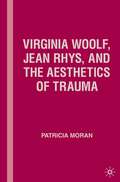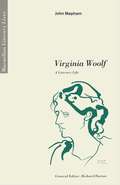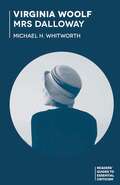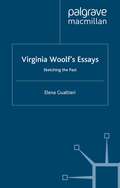- Table View
- List View
Virginia Woolf and the Russian Point of View
by R. RubensteinThis book brings together Virginia Woolf's essays and book reviews on Russian literature; her unpublished reading notes on Tolstoy, Dostoevsky, Chekhov, and Turgenev; and new and insightful scholarly commentary concerning her response to each of the major Russian writers.
Virginia Woolf and the World of Books (Clemson University Press)
Virginia Woolf and the World of Books will examine Leonard and Virginia Woolf’s Hogarth Press as a key intervention in modernist and women’s writing and mark its importance to independent publishing, bookselling, and print culture at large. The research in this volume coincides with the centenary of the founding of Hogarth Press in 1917, thus making a timely addition to scholarship on the Woolfs and print culture.
A Virginia Woolf Chronology (Author Chronologies Series)
by Edward BishopAn attempt to draw together the important details of Woolf's working life in a single volume, allowing the reader to trace her development as novelist, feminist and literary journalist against the background of the age.
Virginia Woolf: Dramatic Novelist
by J. WheareJane Wheare concerns herself with Virginia Woolf's artistry in "The Voyage Out", "Night and Day" and "The Years", where Woolf exploited and developed the "realist" model, finding in it the most appropriate vehicle through which to put across obliquely her own ideas about women and society.
Virginia Woolf, Europe, and Peace: Vol. 2 Aesthetics and Theory (Clemson University Press)
From the “prying,” “insidious” “fingers of the European War” that Septimus Warren Smith would never be free of in Mrs Dalloway to the call to “think peace into existence” during the Blitz in “Thoughts on Peace in an Air Raid,” questions of war and peace pervade the writings of Virginia Woolf. This volume asks how Woolf conceptualised peace by exploring the various experimental forms she created in response to war and violence. Comprised of fifteen chapters by an international array of leading and emerging scholars, this book both draws out theoretical dimensions of Woolf’s modernist aesthetic and draws on various critical frameworks for reading her work, in order to deepen our understanding of her writing about the politics of war, ethics, feminism, class, animality, and European culture. The chapters collected here look at how we might re-read Woolf and her contemporaries in the light of new theoretical and aesthetical innovations, such as peace studies, post-critique, queer theory, and animal studies. It also asks how we might historicise these frameworks through Woolf’s own engagement with the First and Second World Wars, while also bringing her writings on peace into dialogue with those of others in the Bloomsbury Group. In doing so, this volume reassesses the role of Europe and peace in Woolf’s work and opens up new ways of reading her oeuvre.
Virginia Woolf, Europe, and Peace: Vol. 1 Transnational Circulations (Clemson University Press)
Virginia Woolf, Europe, and Peace: Transnational Circulations enlarges our understanding of Virginia Woolf’s pacifist ideology and aesthetic response to the World Wars by re-examining her writings and cultural contexts transnationally and comparatively through the complex interplay between modernism, politics, and aesthetics. The “transnational” paradigm that undergirds this collection revolves around the idea of transnational cultural communities of writers, artists, and musicians worldwide who were intellectually involved in the war effort through the forging of pacifist cultural networks that arose as a form of resistance to war, militarism, and the rise of fascism. The book also offers philosophical approaches to notions of transnational pacifism, anti-war ethics, and decolonization, examining how Woolf’s prose undermines center/edge or self/other bifurcations. Breathing new life into Woolf’s anti-war writings through a transnational lens and presenting us with the voices and perspectives of a range of significant scholars and critics, the chapters in this volume engage with mobile and circulatory pacifisms, calling attention to the intersections of modernist inquiries across the arts (art, music, literature, and performance) and transnational critical spaces (Asia, Europe, and the Americas) to show how the convergence of different cultural and linguistic horizons can significantly expand and enrich our understanding of Woolf’s modernist legacy.
Virginia Woolf, Fashion and Literary Modernity: Fashion And Literary Modernity (Edinburgh University Press)
by R. S. KoppenNewly available in paperback, this study places Woolf´s writing in the context of sartorial practice from the Victorian period to the 1930s
Virginia Woolf: The Frames of Art and Life
by C. Ruth MillerAn attempt to illuminate Virginia Woolf's aesthetic by providing an original thoery regarding her use of the random frames provided by life. Her novels are shown to use windows, thresholds, mirrors and, less directly, rooms to frame scenes which chart the border between life and art.
Virginia Woolf, Jean Rhys, and the Aesthetics of Trauma
by P. MoranThis is a study of modernism, sexuality, and subjectivity in the work of two leading women modernists. Each confronted the aspects of her culture and personal history that resulted in a degraded sense of female sexuality and explored how traumatic childhood sexual experiences informed their relationship to female corporeality and fiction-writing.
Virginia Woolf A Literary Life (Literary Lives Ser.)
by J. MephamThis book tells the story of Virginia Woolf's literary career. It emphasises the importance of her ownership of the Hogarth Press, whereby she gained the freedom to write as she pleased. This made possible a career of extraordinary formal innovations. Each of her books was unlike every other. Her career was a series of different choices, statements and masks. This book attempts to discover why, at each point in her career, she chose to write as she did.
Virginia Woolf, Literary Materiality, and Feminist Aesthetics: From Pen to Print (Material Modernisms)
by Amber JenkinsThis book interrogates the relationship between the material conditions of Woolf's writing practices and her work as a printer and publisher at the Hogarth Press. In bringing to light her embodied literary processes, from drafting and composition to hand-printing and binding, this study foregrounds the interactions between Woolf's modernist experimentation and the visual and material aspects of her printed works. By drawing on the field of print culture, as well as the materialist turn in Woolf scholarship, it explores how her experience in print, book-design and publishing underlines her experimental writing, and how her literary texts are conditioned by the context of their production. This book, therefore, provides new ways of reading Woolf's modernism in the context of twentieth-century print, material, and visual cultures. By suggesting that Woolf's work at the Hogarth Press sensitized her to the significant role the visual aspects of a text play in its system of representation, it also considers the extent to which materiality informs both her work, as well as her engagement with Bloomsbury formalist aesthetics, which often exaggerate the distinction between visual and verbal modes of expression.
Virginia Woolf, Modernity and History: Constellations with Walter Benjamin
by Angeliki SpiropoulouThis book analyses the representation of the past and the practice of historiography in the fiction and critical writings of Virginia Woolf, and draws parallels between Woolf's historiographical imagination and the thought of Walter Benjamin, the German philosopher of history and key theorist of modernity.
Virginia Woolf - Mrs Dalloway (Readers' Guides to Essential Criticism)
by Michael WhitworthVirginia Woolf's Mrs Dalloway (1925) has long been recognised as one of her outstanding achievements and one of the canonical works of modernist fiction. Each generation of readers has found something new within its pages, which is reflected in its varying critical reception over the last ninety years. As the novel concerns itself with women's place in society, war and madness, it was naturally interpreted differently in the ages of second wave feminism, the Vietnam War and the anti-psychiatry movement. This has, of course, created a rather daunting number of different readings. Michael H. Whitworth contextualizes the most important critical work and draws attention to the distinctive discourses of critical schools, noting their endurance and interplay. Whitworth also examines how adaptations, such as Michael Cunningham's The Hours, can act as critical works in themselves, creating an invaluable guide to Mrs Dalloway.
Virginia Woolf - Mrs Dalloway (Readers' Guides to Essential Criticism)
by Michael WhitworthVirginia Woolf's Mrs Dalloway (1925) has long been recognised as one of her outstanding achievements and one of the canonical works of modernist fiction. Each generation of readers has found something new within its pages, which is reflected in its varying critical reception over the last ninety years. As the novel concerns itself with women's place in society, war and madness, it was naturally interpreted differently in the ages of second wave feminism, the Vietnam War and the anti-psychiatry movement.This has, of course, created a rather daunting number of different readings. Michael H. Whitworth contextualizes the most important critical work and draws attention to the distinctive discourses of critical schools, noting their endurance and interplay. Whitworth also examines how adaptations, such as Michael Cunningham's The Hours, can act as critical works in themselves, creating an invaluable guide to Mrs Dalloway.
Virginia Woolf: Public and Private Negotiations
by A. SnaithIn Virginia Woolf: Public and Private Negotiations , Anna Snaith explores the centrality of ideas of public and private in Woolf's life and writing. The book offers a fresh understanding of Woolf's feminism, her narrative techniques, her attitudes to publication, and her role in public debate. It draws on new manuscript material and previously unexplored letters to Woolf from her reading public.
Virginia Woolf: Writing the World (Clemson University Press)
by Pamela Caughie Diana SwansonWoolf Writing the World addresses such themes as the creation of worlds through literary writing, Woolf’s reception as a world writer, world wars and the centenary of the First World War, and natural worlds in Woolf’s writings. The selected papers represent the major themes of the conference as well as a diverse range of contributors from around the world and from different positions in and outside the university. The contents include familiar voices from past conferences--e.g., Judith Allen, Eleanor McNees, Elisa Kay Sparks--and well-known scholars who have contributed less frequently, if at all, to past Selected Papers--e.g., Susan Stanford Friedman, Steven Putzel, Michael Tratner--as well as new voices of younger scholars, students, and independent scholars. The volume is divided into four themed sections. The first and longest section, War and Peace, is framed by Mark Hussey’s keynote roundtable, “War and Violence,” and Maud Ellmann’s keynote address, “Death in the Air: Virginia Woolf and Sylvia Townsend Warner in World War II.” The second section, World Writer(s), includes papers that read the Woolfs in a global context. The papers in Animal and Natural Worlds bring recent developments in ecocriticism and post-humanist studies to analysis of Woolf’s writing of human and nonhuman worlds. Finally, Writing and Worldmaking addresses various aspects of genre, style, and composition. Madelyn Detloff’s closing essay, “The Precarity of ‘Civilization’ in Woolf’s Creative Worldmaking,” brings us back to international and cultural conflicts in our own day, reminding us, as Detloff says, why Woolf still matters today.
Virginia Woolf’s Afterlives: The Author as Character in Contemporary Fiction and Drama (Routledge Auto/Biography Studies)
by Monica LathamThis book explores Virginia Woolf’s afterlives in contemporary biographical novels and drama. It offers an extensive analysis of a wide array of literary productions in which Virginia Woolf appears as a fictional character or a dramatis persona. It examines how Woolf’s physical and psychological features, as well as the values she stood for, are magnified, reinforced or distorted to serve the authors’ specific agendas. Beyond general theoretical issues about this flourishing genre, this study raises specific questions about the literary and cultural relevance of Woolf’s fictional representations. These contemporary narratives inform us about Woolf’s iconicity, but they also mirror our current literary, cultural and political concerns. Based on a close examination of twenty-five works published between 1972 and 2019, the book surveys various portraits of Woolf as a feminist, pacifist, troubled genius, gifted innovative writer, treacherous, competitive sister and tragic, suicidal character, or, on the contrary, as a caricatural comic spirit, inspirational figure and perspicacious amateur sleuth. By resurrecting Virginia Woolf in contemporary biofiction, whether to enhance or debunk stereotypes about the historical figure, the authors studied here contribute to her continuous reinvention. Their diverse fictional portraits constitute a way to reinforce Woolf’s literary status, re-evaluate her work, rejuvenate critical interpretations and augment her cultural capital in the twenty-first century
Virginia Woolf’s Afterlives: The Author as Character in Contemporary Fiction and Drama (Routledge Auto/Biography Studies)
by Monica LathamThis book explores Virginia Woolf’s afterlives in contemporary biographical novels and drama. It offers an extensive analysis of a wide array of literary productions in which Virginia Woolf appears as a fictional character or a dramatis persona. It examines how Woolf’s physical and psychological features, as well as the values she stood for, are magnified, reinforced or distorted to serve the authors’ specific agendas. Beyond general theoretical issues about this flourishing genre, this study raises specific questions about the literary and cultural relevance of Woolf’s fictional representations. These contemporary narratives inform us about Woolf’s iconicity, but they also mirror our current literary, cultural and political concerns. Based on a close examination of twenty-five works published between 1972 and 2019, the book surveys various portraits of Woolf as a feminist, pacifist, troubled genius, gifted innovative writer, treacherous, competitive sister and tragic, suicidal character, or, on the contrary, as a caricatural comic spirit, inspirational figure and perspicacious amateur sleuth. By resurrecting Virginia Woolf in contemporary biofiction, whether to enhance or debunk stereotypes about the historical figure, the authors studied here contribute to her continuous reinvention. Their diverse fictional portraits constitute a way to reinforce Woolf’s literary status, re-evaluate her work, rejuvenate critical interpretations and augment her cultural capital in the twenty-first century
Virginia Woolf's Bloomsbury, Volume 1: Aesthetic Theory and Literary Practice
by G. Potts L. ShahriariThis volume features new essays by eminent and emerging Woolf scholars, focusing on the aesthetics and influences of Virginia Woolf's work. Themes include eco-criticism, conceptions of intellectual women, spaces and places, and Woolf beyond Bloomsbury. The volume opens with a personal reflection by Cecil Woolf, nephew of Leonard and Virginia Woolf.
Virginia Woolf’s Bloomsbury, Volume 2: International Influence and Politics
by L. Shahriari G. PottsThis volume features new essays by eminent and emerging Woolf scholars from around the world, focusing on Virginia Woolf's and Bloomsbury's politics. Themes include war, freedom of the press, economics and cultural production, the Hogarth Press, the global circulation of ideas, and transformations to the public sphere.
Virginia Woolf's Common Reader
by Katerina KoutsantoniIn the first comprehensive study of Virginia Woolf's Common Reader, Katerina Koutsantoni draws on theorists from the fields of sociology, sociolinguistics, philosophy, and literary criticism to investigate the thematic pattern underpinning these books with respect to the persona of the 'common reader'. Though these two volumes are the only ones that Woolf compiled herself, they have seldom been considered as a whole. As a result, what they reveal about Woolf's position with regard to the processes of writing, reading, and critical analysis has not been fully examined. Koutsantoni challenges the critical commonplace that equates Woolf's strategy of self-effacement and personal removal from her works as a necessary compromise that allowed her to achieve authorial recognition in a male-dominated context. Rather, Koutsantoni argues that an investigation of impersonality in Woolf's essays reveals the potential of the genre to function both as a vehicle for the subjective and dialogic expression of the author and reader and as a venue for exploring topics with which the ordinary reader can relate. As she explores and challenges the meaning of impersonality in Woolf's Common Reader, Koutsantoni shows how the related issues of subjectivity, authority, reader-response, intersubjectivity, and dialogism offer useful perspectives from which to examine Woolf's work.
Virginia Woolf's Common Reader
by Katerina KoutsantoniIn the first comprehensive study of Virginia Woolf's Common Reader, Katerina Koutsantoni draws on theorists from the fields of sociology, sociolinguistics, philosophy, and literary criticism to investigate the thematic pattern underpinning these books with respect to the persona of the 'common reader'. Though these two volumes are the only ones that Woolf compiled herself, they have seldom been considered as a whole. As a result, what they reveal about Woolf's position with regard to the processes of writing, reading, and critical analysis has not been fully examined. Koutsantoni challenges the critical commonplace that equates Woolf's strategy of self-effacement and personal removal from her works as a necessary compromise that allowed her to achieve authorial recognition in a male-dominated context. Rather, Koutsantoni argues that an investigation of impersonality in Woolf's essays reveals the potential of the genre to function both as a vehicle for the subjective and dialogic expression of the author and reader and as a venue for exploring topics with which the ordinary reader can relate. As she explores and challenges the meaning of impersonality in Woolf's Common Reader, Koutsantoni shows how the related issues of subjectivity, authority, reader-response, intersubjectivity, and dialogism offer useful perspectives from which to examine Woolf's work.
Virginia Woolf's Essayism
by Randi SalomanExplores the way Woolf used essay-writing techniques to develop her conception of the modern novel.The focus of this study is on Virginia Woolf's vast output of essays and their relation to her fiction. Randi Saloman shows that it was by employing tools and methods drawn from the essay genre - such as fragmentation, stream-of-consciousness and dialogic engagement with the reader - that Woolf managed to leave behind the realism of the 19th-century novel. Saloman draws on key theorists of the essay such as T. W. Adorno and Georg Lukács, as well as on more recent scholars of 'essayism' (a term devised by Robert Musil to describe the hypothetical quality of the essay mode). She shows that the essay, as genre and mode, shaped Woolf's writing, and modern fiction more generally, in ways that have not yet been articulated. Key Features:* In-depth consideration of Virginia Woolf's shorter essays* Revisionary accounts of /A Room of One's Own/ (1929) and /Three Guineas/ (1938)* New readings of Woolf's major and less well-known novels, including /The Pargiters/, her failed 'essay-novel'* Repositions the essay as a major modernist genre, responsible in large part for the creation of the modern (and especially the 'modernist') novelKeywords: Virginia Woolf, Modernism, The Essay, Fiction, Essayism, The Novel, Genre
Virginia Woolf's Essayism
by Randi SalomanExplores the way Woolf used essay-writing techniques to develop her own conception of the modern novel. This book forcuses on Woolf's vast output of essays and their relation to her fiction. Saloman shows that it was by employing tools and methods drawn from the essay genre that Woolf managed to leave behind the realism of the 19th-century novel.
Virginia Woolf's Essays: Sketching the Past
by E. GualtieriAlthough marginal and often neglected genres, the sketch and the essay represented for Virginia Woolf the two forms of writing through which she articulated her understanding of the workings of literary history. In this innovative study, Elena Gualtieri analyses in detail the intersection between essays and sketches in Woolf's non-fiction as part of a far-reaching argument about the scopes and models of feminist criticism, its understanding of the historical process and its position in the panorama of twentieth-century intellectual history.






















